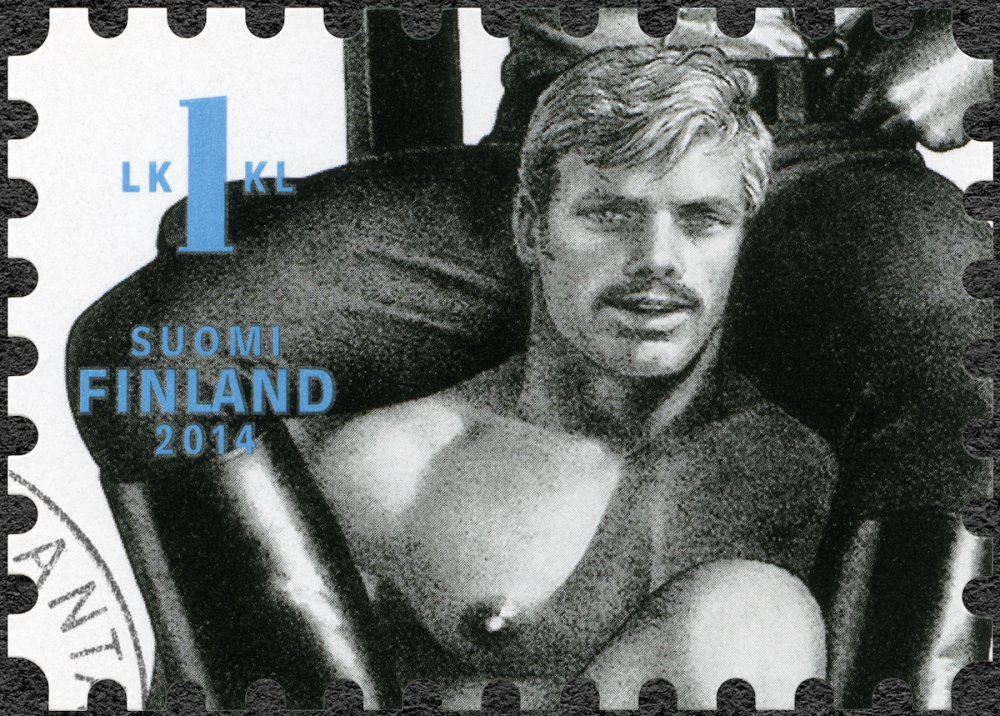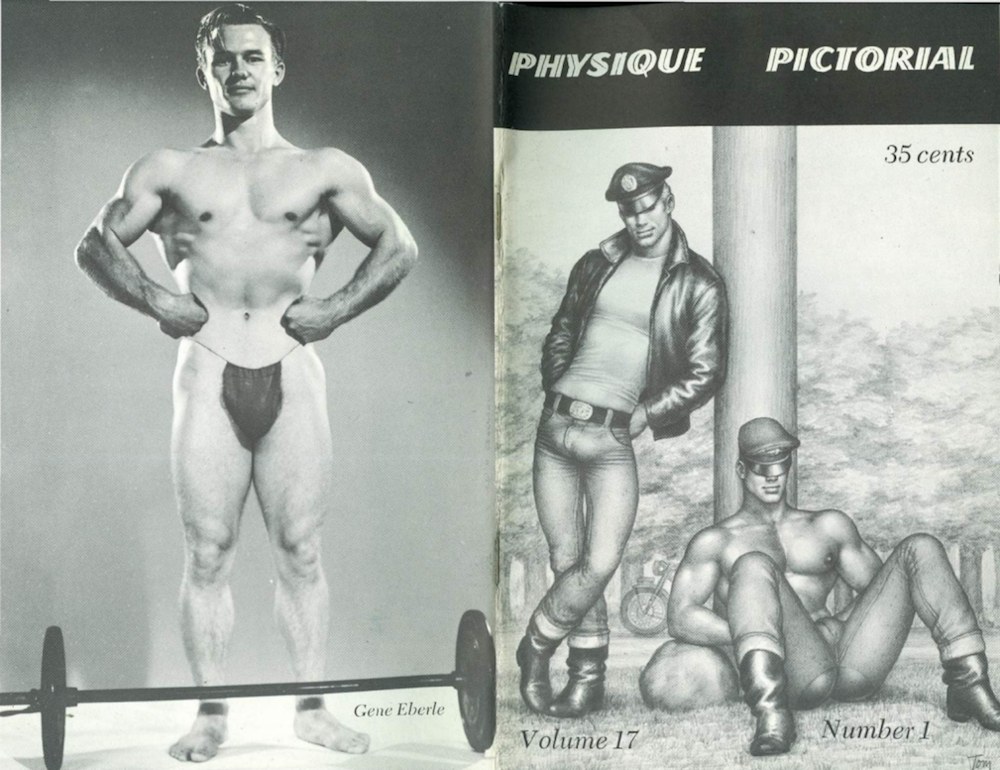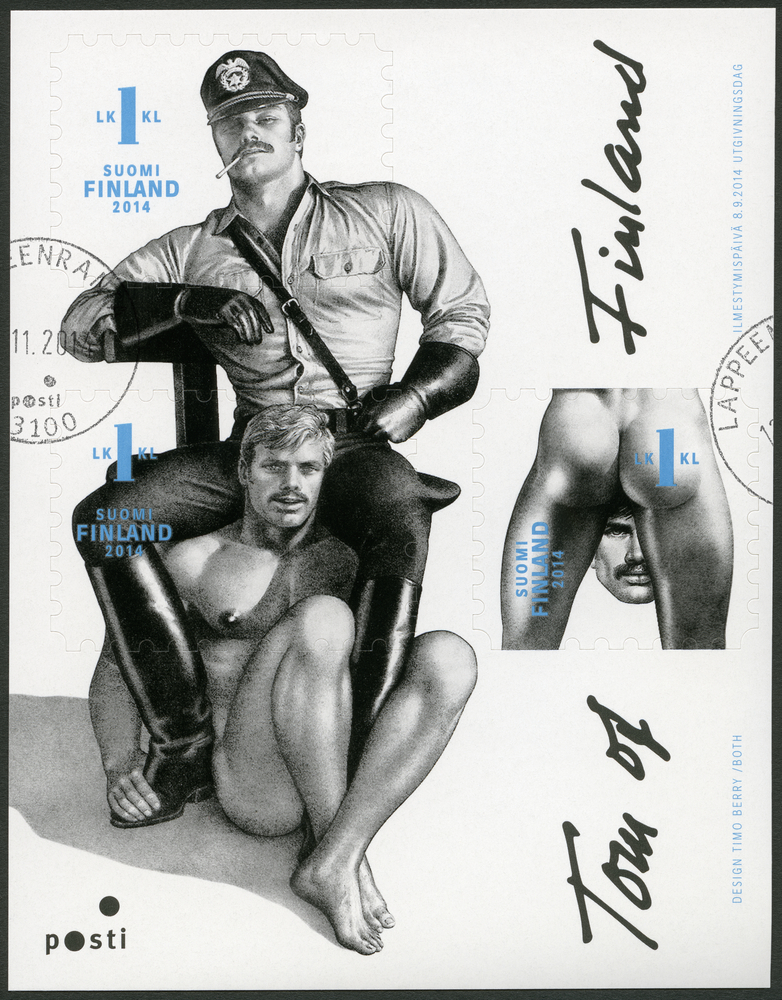Once viewed by some as obscene or pornographic, Tom of Finland's artwork of gay muscle and leather men now hangs in major museums across the world. As 8 May is Tom of Finland day, Alex Hopkins takes a retrospective look at Tom's life and rise to artwork success.
“My whole life long I have done nothing but interpret my dreams of ultimate masculinity, and draw them,” said Tom of Finland. And what dreams they must have been! With their tumescent todgers, super-sized muscles and joyful sexuality, Tom of Finland’s homoerotic art created a bold, new gay aesthetic.
Dismissed in some quarters as distasteful and obscene for much of his life, Tom of Finland's artwork is finally receiving recognition with exhibitions in major galleries and museums across the world. Here’s all you need to know about Finland’s most uncompromising and controversial artist.
Tom of Finland artwork: private fantasies
Born in 1920 in Kaarina, Finland, Touko Valio Laaksonen began creating what he called his ‘dirty drawings’ while studying advertising at university in Helsinki. Initially, he was documenting his sexual fantasies, which often revolved around the big, butch labourers he’d seen and desired while growing up.

Tom of Finland: Touko Laaksonen Wikimedia Commons
However, he destroyed these drawings when he was forced to join the Finnish army – allied with the Nazis – in 1940. While detesting the Nazis, he was nevertheless transfixed by their leather boots. “They had the sexiest uniforms,” he mused as he started drawing them.
Basking in Brando
A celluloid encounter with the magnificent Marlon Brando in 1953’s The Wild Ones transformed Tom of Finland's artwork. Defiant, dangerous-to-know and rebellious, Brando played Johnny Strabler, head of a motorcycle club intent upon mayhem.
The brown leather of Tom’s earlier illustration of army officers was replaced by the sexy black leather, white t-shirt and cloth hat of the Brando look. And his subjects became beautiful blue-collar men. Sailors. Builders. Lumberjacks. Tough guys revered for their strength and the sumptuous salami they packed down south.

Tom of Finland's artwork has even appeared on stamps shutterstock/Olga Popova
Crucially, clothing was always key to these men’s appeal for Tom. “To me, a fully dressed man is more erotic than a naked one,” he said. His other rule, used to judge his own work, was no less compromising: the impact his illustrations had on his own cock. “If I don’t have an erection when I’m doing a drawing, I know it’s no good,” he added.
Porn, perversion and subversion
In its rejection of conformity, the post-war biker culture was the ideal springboard for Tom of Finland's artwork. His men were unapologetically physical, almost wild in the way they reveled in their sexuality. Indeed, what’s so striking, even now, about his images is the happiness on the men’s faces. Playful, smiling and supremely self-assured, his subjects are invariably brimming with pride at their antics and awesome physical attributes.
And it was this pride that gave the work its power, particularly considering the dominant narratives about homosexuality in the 1950s. Back then, homosexuality was still classified as a medical disorder, with gay men commonly seen as weak and tragic.
But Tom of Finland set about challenging ideas of homosexuality and effeminacy through a confrontational, outrageous visual language that spoke directly to gay men – many of them still closeted. His work was much more than pornography. It was subversive art, shattering stereotypes, helping sexual outsiders feel empowered and less alone.
“In its rejection of conformity, the post-war biker culture was the ideal springboard for Tom of Finland's artwork. His men were unapologetically physical, almost wild in the way they reveled in their sexuality.”
And this was no mean feat in conservative Finland, where homosexuality wasn’t decriminalized until 1971. Tom was even once jailed when a pick-up went wrong, and his own sister even considered his work shameful. Yet, undaunted, he continued to beaver away on his artwork in secret.
His big break came in 1956 when he sent images to the American beefcake magazine Physique Pictorial. He signed the image ‘Tom’. However, the magazine’s editor Bob Mizer added the words ‘of Finland’, giving the master draughtsman his legendary artist’s name.
Bring on the beefcake!
A self-taught photographer, Bob Mizer knew only too well the challenges of disseminating erotic images of men amid heavy US censorship in the 1950s. But he had an ingenious workaround to the ban on gay porn.
Under the pretense of health and fitness, beefcake magazines offered closeted gay men a ready supply of hot and horny bodybuilders donning devastatingly revealing briefs. And through these magazines, Tom of Finland's art reached a wider audience.

Tom of Finland art in Physique Pictorial magazine Wikimedia
Enter Kake
In 1962, a groundbreaking legal case saw soft porn magazines appear in the US for the first time. And the ramifications for Tom of Finland's art were profound. Indeed, his drawings became more explicit. The genitals became gargantuan – the muscles extraordinarily engorged – as he began to incorporate fantastical elements of storytelling.
The result was gay leatherman extraordinaire, Kake, unleashed in 1968 and featured in a series of comics, which allowed Tom to depict different scenarios and stages in gay men’s relationships.
MORE LIKE THIS:
Promiscuous, genial, monumentally endowed – at times surprisingly tender but always irresistible – Kake was the antithesis of the threatening images of gay leathermen depicted by so-called ‘respectable’ straight society. Typically found in cruising grounds and public toilets, Kake capitalised on the free love movement of the 1960s, adding a bold new political aspect to Tom of Finalnd’s art.
The US: a brave new world
Despite growing, albeit largely underground, international interest in his work, Tom didn’t abandon his advertising career until 1973. Moreover, he didn’t make his first trip to the US until 1978, when he exhibited in Los Angeles. Further exhibitions followed in San Francisco and New York, where, coinciding with gay liberation, he was feted by artists such as Robert Mapplethorpe (himself no stranger to controversy) and Andy Warhol.

Stamps featuring Tom's artwork Olga Popova/shutterstock
Yet many in the artistic establishment still refused to treat his work seriously. But Tom admirably forged ahead, embracing a more photorealistic style, which added even more exquisite detail to his ever-wilder sexual imaginings.
Tom of Finland art: a lustful legacy
Tom died of emphysema in 1991 aged 71. But his legacy has been kept alive by The Tom of Finland Foundation, co-founded in 1984 by Tom’s friend Durk Dehner.
‘More than 100 years since Tom of Finland’s birth, it seems his work is starting to be embraced by a “mainstream” audience to a degree,’ says Champ Daniels and Richard Villani of the Foundation.
‘In 2014, the Finnish postal service released a Tom of Finland postage stamp. AllTogether, an exhibition of work from Tom of Finland Foundation's permanent collection opened alongside the 2022 Venice Biennale, and was sponsored by Diesel. And this year, our annual Tom of Finland Art & Culture Festival expands to Berlin in May at prideART at the Knast. But we still struggle with censorship of Tom's and others' artwork on social media.’
“More than 100 years since Tom of Finland’s birth, it seems his work is starting to be embraced by a “mainstream” audience to a degree.”
The Foundation, based in Los Angeles, also works with queer artists through an Artist-in-Residence program. Additionally, it holds the Tom of Finland Emerging Artist Competition every two years.
‘Artists-in-Residence, as well as visiting scholars and artists, have the opportunity to delve into the Foundation's archives,’ explains Daniels and Villani. ‘Whether they seek preparatory drawings or rare pastel works by Tom, for instance, the collection is at their disposal. Artists in turn often draw inspiration from TOM's men, his work, and his life.’
And what inspiration he continues to provide! Far more than mere masturbatory fodder, Tom of Finland’s vast collection of illustrations offers invaluable insights into pivotal points in gay male history and the policing of sexuality. Indeed, his work, in our increasingly sex-positive times, is arguably more relevant than ever.
But perhaps Tom himself put it best: “I was determined that, in my drawings at least, gay men would be open and masculine, and the sex, no matter how heavy, would always be free and positive and every story would end happily.” And what gay man could take issue with such an affirmative message? •
Main image: Olga Popova/shutterstock
-
 1
1




Join the conversation
You are posting as a guest. If you have an account, sign in now to post with your account.
Note: Your post will require moderator approval before it will be visible.
There are no comments to display.